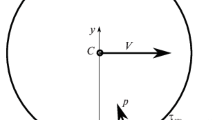Abstract
Rolling with the slipping of an infinite elastic cylinder with a horizontal axis in the gravity field on a flat surface made of the same material is considered. The angle between the nondeformed boundary of the surface and the horizon is nonzero. Based on solution of the corresponding contact problem in Carter’s quasi-static formulation, the reaction of the flat surface in dynamic equations is determined. It is shown that if the tangent of the inclination angle does not exceed the product of the friction coefficient and the coefficient that depends on the elastic properties of the material and the mass distribution, motion with constant relative slip δ and a constant acceleration of the center of mass is possible; there is a region in the contact area where the materials stick together. This motion is found to be asymptotically stable with respect to δ. The dependence of the cylinder-axis acceleration on the mechanical properties of the material and the friction coefficient is examined. The results obtained are compared with those of the classical problem of rigid-disk motion along an inclined straight line.




Similar content being viewed by others
REFERENCES
J. I. Nejmark and N. A. Fufaev, Dynamics of Nonholonomic Systems (Am. Math. Soc., Providence, RI, 2004), Vol. 33.
V. V. Rumianstev, “On stability of motion of nonholonomic systems,” J. Appl. Math. Mech. 31 (2), 282–293 (1967).
V. V. Rumiantsev, “On Hamilton’s principle for nonholonomic systems,” J. Appl. Math. Mech. 42 (3), 407–419 (1978).
V. V. Rumiantsev, “On the Lagrange and Jacobi principles for nonholonomic systems,” J. Appl. Math. Mech. 43 (4), 625–632 (1979).
V. V. Rumianstev, “On general equations of motions,” in Nonlinear Dynamics (Fizmatlit, Moscow, 2001), pp. 4–38.
P. Appell, Traité de Mécanique Rationnelle, Vol. 2: Dynamique des Systemes Méchanique Analytique (Gauthier-Villars, Paris, 1953).
A. De Ambrosis, M. Malgieri, P. Mascheretti, and P. Onorato, “Investigating the role of sliding friction in rolling motion: a teaching sequence based on experiments and simulations,” Eur. J. Phys. 36 (3), Pap. No. 035020 (2015).
Á. Suárez, D. Baccino, and A. C. Martí, “Video-based analysis of the transition from slipping to rolling,” Phys. Teacher 58 (3), 170–172 (2020).
T. Pöchel, N. Brilliantov, and A. Zaikin, “Bistability and noise-enhanced velocity of rolling motion,” Europhys. Lett. 69 (3), 371–377 (2005).
A. S. Kuleshov, D. V. Treschev, T. B. Ivanova, and O. S. Naimushina, “A rigid cylinder on a viscoelastic plane,” Nelineinaya Din. 7 (3), 601–625 (2011).
J. Ai, J.-F. Chen, J. M. Rotter, and J. Y. Ooi, “Assessment of rolling resistance models in discrete element simulations,” Powder Technol. 206 (3), 269–282 (2011)
F. W. Carter, “On the action of a locomotive driving wheel,” Proc. R. Soc. London A 112, 151–157 (1926).
I. G. Goryacheva, Contact Mechanics in Tribology (Kluwer, Dordrecht, 1998).
I. G. Goryacheva and A. A. Zobova, “Dynamics of rolling with a microslip for an elastic cylinder on an elastic half-space,” Dokl. Phys. 63 (7), 263–265 (2018). https://doi.org/10.3103/S0025654419030117
I. G. Goryacheva and A. A. Zobova, “Dynamics of the motion of an elastic cylinder along an elastic foundation,” Mech. Solids 54 (2), 271–277 (2019). https://doi.org/10.3103/S0025654419030117
I. G. Goryacheva and A. A. Zobova, “Deceleration of a rigid cylinder sliding along a viscoelastic foundation,” Mech. Solids 54 (2), 278–288 (2019). https://doi.org/10.3103/S0025654419030129
A. A. Zobova and I. G. Goryacheva, “Dynamics of a viscoelastic cylinder on a viscoelastic half-space,” Acta Mech. 231 (6), 2217–2230 (2020).
A. A. Zobova and I. G. Goryacheva, “Effect of contacting bodies’ mechanical properties on the dynamics of a rolling cylinder,” Acta Mech. 232, 1971–1982 (2021). https://doi.org/10.1007/s00707-020-02800-w
V. V. Rumyantsev and A. S. Oziraner, Stability and Stabilization of Motion with Respect to Part of the Variables (Nauka, Moscow, 1987) [in Russian].
Funding
The analysis of the solution to the contact problem has been fulfilled as part of state assignment (state registration no. AAAA-A20-120011690132-4); the steady-state solution and its partial stability have been investigated as part of project no. 19-01-00140-а of the Russian Foundation for Basic Research
Author information
Authors and Affiliations
Corresponding authors
Additional information
Translated by M. Shmatikov
APPENDIX 1
APPENDIX 1
Stability of uniformly accelerated motion. We examine stability of solution (5.2) with respect to variable \({{\delta }}\) [19]. We introduce the variables:
The equations of perturbed motion have then the form:
were \(F\left( {x,\operatorname{sign} \left( y \right)} \right) = \tilde {Q}\left( {x + \delta \text{*},\operatorname{sign} \left( y \right)} \right) + \tan \varphi \),
Since for values close to unperturbed motion \(\tilde {V}\left( 0 \right) > 0\), \(y ' > 0\), we have \(y\left( {{\tau }} \right) > 0\) for all \({{\tau }} > 0\). Consequently,
We consider the auxiliary equation
This equation has the solution \(\bar {x} = 0\). We have in the vicinity of this solution
We now prove that the coefficient \({{k}_{1}} < 0\). Indeed,
We note that since \( - \mu {\text{/}}\left( {2\kappa } \right) < {{\delta }}\text{*} < 0\), it follows from Eq. (4.3) that
In addition, \(w\left( {{{\delta }} \text{*}} \right) > 0\), consequently, \({{k}_{1}} < 0\).
Disregarding the terms on the order of \(O({{\bar {x}}^{2}})\), we obtain from Eq. (8.2) an equation with separable variables:
We arrive then at:
whence
The index of power is negative implying that the \(\bar {x}\) function defined by auxiliary equation (8.2) decreases as a power function of time. Since majorizing equations can be derived for initial system (8.1) based on the auxiliary equation, solution (5.2) of the initial system is asymptotically stable with respect to variable \({{\delta }}\).
About this article
Cite this article
Zobova, A.A., Goryacheva, I.G. On the Stability of the Uniformly Accelerated Motion of an Elastic Cylinder on an Inclined Flat Surface. Mech. Solids 56, 1559–1568 (2021). https://doi.org/10.3103/S0025654421080197
Received:
Revised:
Accepted:
Published:
Issue Date:
DOI: https://doi.org/10.3103/S0025654421080197



